The Apple Thunderbolt Display Review
by Anand Lal Shimpi on September 23, 2011 2:56 AM EST- Posted in
- Displays
- Mac
- Apple
- Thunderbolt
- Thunderbolt Display
Dissection
If you haven't gathered by now, the Thunderbolt Display isn't a regular monitor - it has a lot of components inside that you'd typically only find in a full fledged computer. Being the curious cat I am, I wanted to see inside. Apple isn't too fond of us poking around inside their review samples, but luckily the Crabtree Valley Mall Apple Store just got Thunderbolt Displays in so I hopped in the practical-wagon and grabbed one in the name of science.
Apple has an incredible fascination with using magnets in its designs. What it enables are some pretty neat enclosures, particularly on its displays. The glass front of the Thunderbolt Display is actually identical to what's used on the 27-inch LED Cinema Display and iMac. The glass is held to the chassis via several very strong magnets. To remove the glass you'll need to use suction cups:
Behind the glass front is the actual LCD panel itself. The LCD and backlight are enclosed in a single unit. What we're interested in is behind the LCD however. Unplug a few cables and remove a grounding screw and the LCD unit is easily cast aside. Behind it are two discrete PCBs:
The PCB on the left is the monitor's power supply. Looking at another half-wave rectifier isn't on my to-do list this time, so we turn our attention to the right PCB. This is the board that handles all of the IO on the Thunderbolt Display. All of the screws we've removed thus far just need a T9/T10 torx bit.
The Thunderbolt Display's motherboard is full of controllers driving all of the rear facing IO ports. Contrary to what we originally posted, I now believe this is the same Light Ridge controller we've seen on other Macs (not the MacBook Air):
The external Thunderbolt cable actually continues inside the display and ends up at an internal Thunderbolt port. The cable terminates at the port and then is routed via traces on the PCB to the Eagle Ridge chip:
The other controllers are sprinkled around the PCB, although there's enough space between all of them to make routing nice and easy. The beauty of designing PCBs for monitors like this is you have tons of room to work with.
Pericom provides a PCIe x1 to 4-USB-port adapter on the board:
The internal speakers are driven by a combination of an ST-NXP 0161ET USB audio controller and an Analog Devices ADAV4601 audio processor. The ST-NXP controller sits on an internal USB interface, while the ADAV4601 dangles off of it.
That wraps it up for the front of the PCB. Around back there's a collection of stereo amps as well as the GigE (Broadcom BCM57761) and FW800 (LSI L-FW643E-2) controllers.
There's nothing immediately apparent in the PCB design that would point to the cause of the issue we saw with the Promise Pegasus interfering with the Thunderbolt Display's USB audio controller. The root cause must be exclusive to the Pegasus.








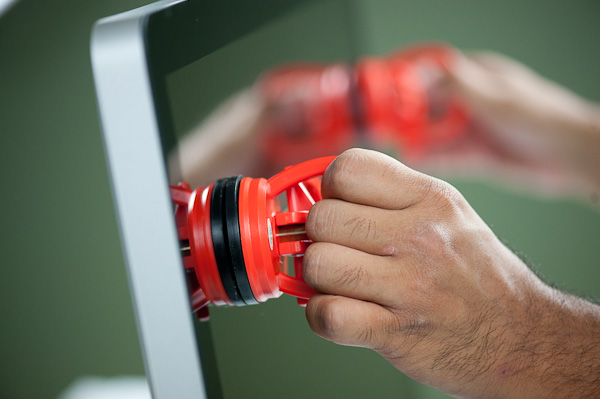
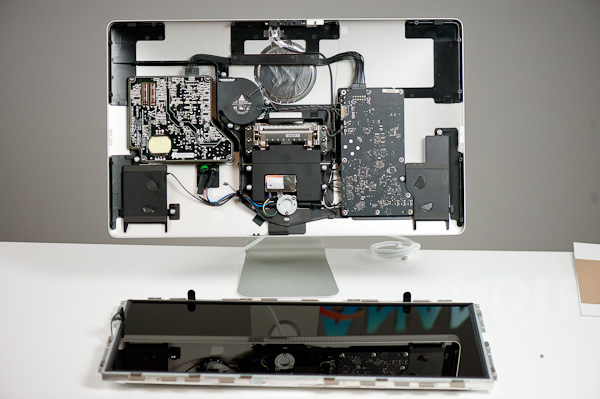
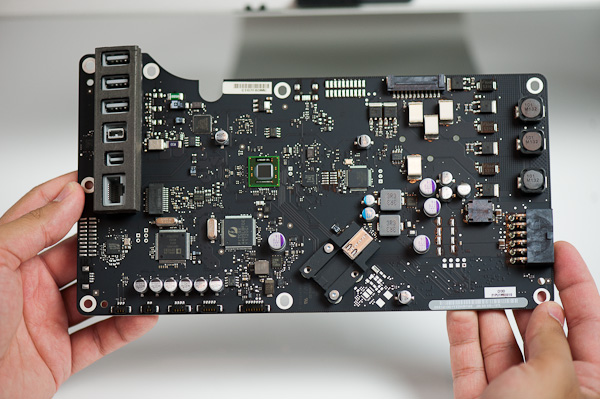
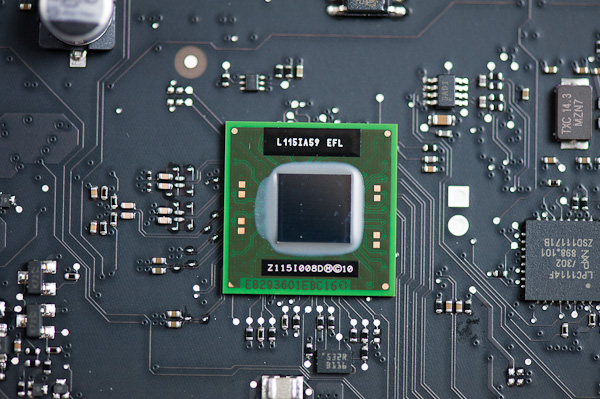
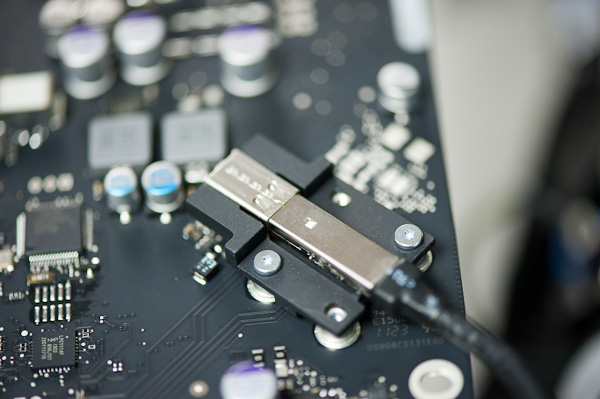
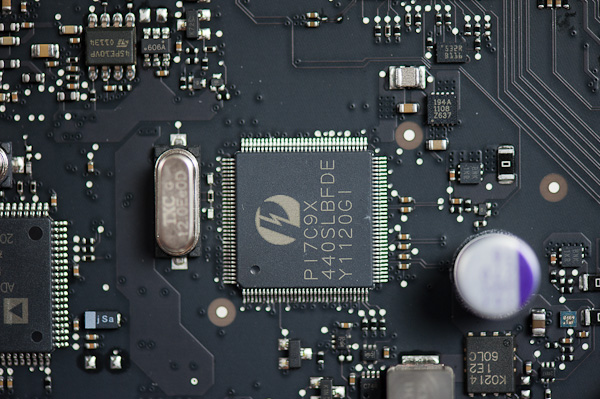
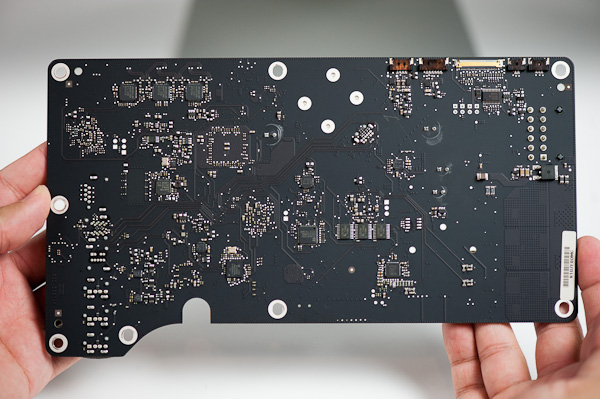
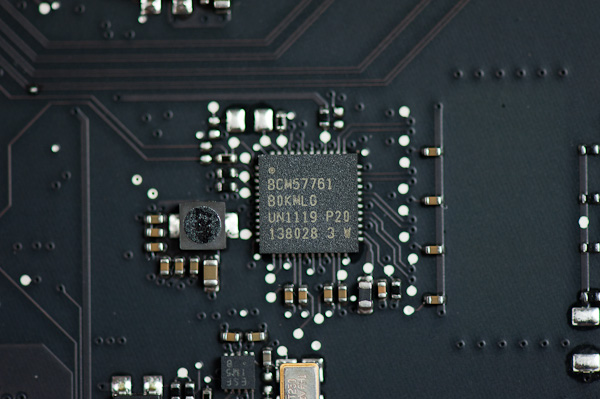








275 Comments
View All Comments
mczak - Friday, September 23, 2011 - link
I'm wondering what the performance would be like? Looks to me like you'd get a far bigger performance hit in this case.Constructor - Friday, September 23, 2011 - link
That would be very interesting indeed.In a discussion over at ars I've been speculating about some of the possible complications with that setup:
http://arstechnica.com/civis/viewtopic.php?t=11558...
(Same user name there.)
Anand, it would be very interesting if you could find out more about the inner workings and the performance consequences of such a combination, possibly confirming or disproving my speculation on the matter.
Over at Macworld they even seem to have made a Cinema display work when plugged in to a Pegasus RAID daisy-chained to a Thunderbolt display. The implications of that and the potential impact on Thunderbolt throughput would be most interesting as well... ;-)
AlexCheng - Friday, September 23, 2011 - link
Sorry guys, but maybe I didn't quite catch it; what exactly is it using as its power supply source? Because it said that the MagSafe port could charge your MacBooks, then where the hell is the cable for its power??Constructor - Friday, September 23, 2011 - link
The display has an ordinary power cable which you'll need to plug into a wall outlet. And the display then powers and charges the MacBok Air/Pro.ltcommanderdata - Friday, September 23, 2011 - link
If Apple goes through with removing the optical drive for the MacBook Pro, hopefully they'll add an optical drive to the Thunderbolt Display. That would make the Thunderbolt Display very complete as a dock.dBoze - Friday, September 23, 2011 - link
Anand,When you mention there is "no analog audio out", I think the inclusion of even analog audio would be a bit of a slap in the face. All Macs in recent history include digital audio through the 1/8" jack via 1/8" TOSLINK, Us Mac users are far too cool for analog ;).
Another solution for digital audio without an extra cable to your MacBook would be using AirPort Express. This will give you a digital or audio connection to your speakers over the network, and you can even plug it into your network via ethernet if your wireless signal isn't too strong. If I recall correctly, you can choose your AirPort Express as the "device for sound output" under the "Output" tab in "Sound" under sys preferences. Of course, you're limited to using AirPlay-compatible applications (iTunes) on the Windows side of things.
Constructor - Friday, September 23, 2011 - link
All recent Macs have both analog (electrical) and digital (optical) audio ports in the same socket. Analog is for convenience, digital is for avoidance of ground loops and of analog signal degradation.An additional audio port (USB/FireWire/Thunderbolt) is possible, if inconvenient.
stanwood - Friday, September 23, 2011 - link
Nice review!A lot of comments about how Apple could have built this display is a way that made it more easily upgradable. This is a PC mentality (which I share). Apple rejects it. Don't waste your time asking for it. If you must have some Mac love, use these 3 simple rules:
1) Buy all your Apple gear in a single release cycle.
1a) Go ahead and upgrade the OS. Those are actually pretty cheap.
2) Use it until you hate it or can't resist getting the new shiny stuff.
3) Give it all to your grandfather, aunt, or Goodwill and return to step 1.
By the time you get to step 3 Apple will have replaced all the important I/Os. There will be no point in trying to upgrade.
mcnabney - Friday, September 23, 2011 - link
Large, high quality displays are expensive, but last a long time. The iMac and displays like this compell people to discard those expensive displays far ahead of their time and likely buy another display of the same size and resolution.My 27" display is on its third computer and it provides better color accuracy than this expensive new one. That is probably my biggest beef with Apple, sending so many nice IPS displays into the trash/closet long before they wear out or become outdated.
slashbinslashbash - Friday, September 23, 2011 - link
Not any more. Starting with the 2010 27" iMac, there was a DisplayPort which was both an input and an output. Now with all the 2011 iMacs having Thunderbolt, they can all be used as displays for other computers with Thunderbolt display output.